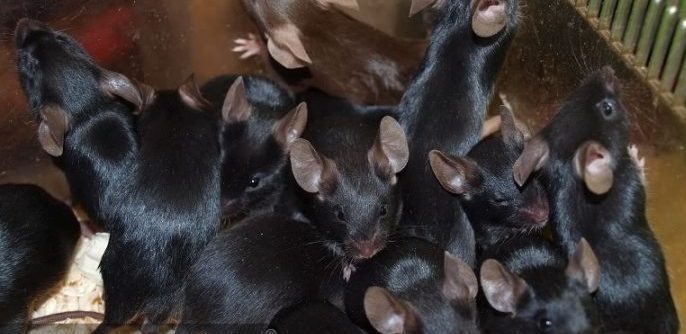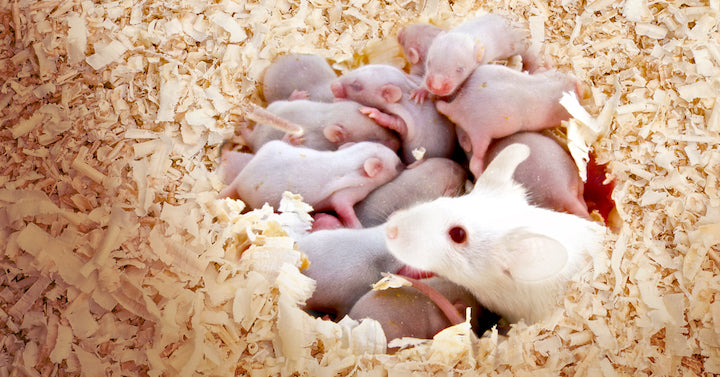According to our recent survey of AALAS members, over 25% of respondents have observed some degree of pup mortality after weaning their mice (see graph below).

After six weeks of caring for your animals during pregnancy and lactation, it is disappointing to lose those precious weanlings and to deal with the consequences of reduced performance on production colonies, loss of valuable transgenic mice, and waste of staff time and resources. Rest assured, the following five helpful tips can improve your weanlings survival through cage transition.
Pups are usually weaned from their parents’ cage at 21 days of age. In intensive breeding programs, make sure to stick to that schedule as gestation in mice is about 21 days. If the first litter is not weaned on time, the female will give birth to a second litter and the cage will become overcrowded, leading to trampling and death of the new pups.
Occasionally, in non-intensive breeding cages, runts or smaller pups can be left with their mother for up to 28 days of age and will benefit from the extra care of the mom’s licking and grooming. Extended weaning can be beneficial, especially for transgenic and genetically modified strains where pups might not be as vigorous as inbreds. Beware, however, to not leave pups passed four weeks. Some strains are sexually mature by 4-5 weeks, and you might end up with unwanted pregnancies and pups. On the other end, early weaning before 21 days—while sometimes necessary for research objectives—is generally not recommended because the pups are too small and might have a harder time on their own. Early weaning has also shown to cause long-term behavioral consequences, with increased stress response and anxiety in adulthood (1).
Weanlings can be uniquely identified by different methods: ear punching, ear tagging, tattooing, microchipping or toe clipping. All methods present advantages and some shortcomings. Use the method that best suits your colony and institution’s requirements in terms of cost, equipment, training and health monitoring!
Most breeding schemes can rely on Mendelian genetics to make predictions on genotype ratios (2). Keep in mind that mating a wild type by a heterozygote (one modified gene), or mating two heterozygotes together will both produce the same number (50%) of heterozygotes! However, mating two heterozygotes together should product 25% homozygotes (two modified genes). If you observe small litters, make sure to check their genotypes: no or rare homozygotes might be a sign that your modification is embryonic lethal.
Males and females should be separated at weaning to avoid unwanted litters from improperly segregated pups. As much as possible, avoid single housing as it deprives the animals from social contact, altering their behavior.
You can pool females from different litters, however, avoid grouping males, as it most probably will lead to aggressive behavior and fighting for dominance.
When harmonious grouping is not possible, single housing of some males, with adapted environmental enrichment, might be better from a welfare standpoint (3). Effects of enrichment vary with both strain and enrichment type : for example, rigid shelters are monopolized by dominant males and tend to increase aggressive behavior, while enrichment that can be manipulated (such as nesting material) was found to decrease aggression.
According to our recent survey of AALAS members, 44% of respondents stated that their weanlings have a hard time finding or using the Lixit or water bottle, thus leading to dehydration, and even mortality, observed by over 26% of respondents.
An easy fix is to provide the newly weaned mice with an additional water source at the bottom of the cage for the first two weeks, to help them transition to their new environment. A growing number of institutions require a water gel to be placed in weaning cages to ensure hydration. HydroGel®, from ClearH2O, is a non-wetting water gel containing 98% water in an easy to use format, and is the #1 choice of laboratory animal breeders worldwide. DietGel® Recovery is another wonderful option for hydration, as it contains 75% water, with additional electrolytes and sugar to accelerate rehydration, very similar to Pedialyte
Weanling health should be monitored daily the first few days following removal of the mother to ensure that they are thriving. Avoid weaning on a Friday if no monitoring will be done over the weekend.
Over 32% of respondents stated that their weanlings have a hard time finding or chewing their feed pellets, and over 42% of respondents report that their institution requires adding softened or moistened food to the bottom of the weaning cage.
ClearH2O DietGel® 76A is a nutritionally fortified soft diet supplement containing protein, fat, carbohydrates, fiber, vitamins and minerals. ClearH2O DietGels are room temperature shelf-stable for 2 years, and a desirable alternative to moistened pellets, saving technician time from preparation. Respondents using ClearH2O gels have reported increased survival and growth of weanlings. For very small and debilitated weanlings, ClearH2O DietGel® Boost is an easily digested, soft texture, high-energy nutritional supplement.
A study from Tufts University showed that providing C57BL/6 breeder cages with DietGel® 76A in addition to regular water and chow increased pup survival to weaning age by 40%. The pups also weighed an average of 17% more than those pups receiving standard chow only.

For more information on breeding colony management, download our Best Practices for Rodent Colony Planning, Breeding Support, and Pup Health Guide. To try our products first hand, Request a Sample.
(1) Early weaning increases anxiety via brain-derived neurotrophic factor signaling in the mouse prefrontal cortex. Kikusui et al., Sci Rep. 2019
(2) Lab Animal Research. Fundamentals of Breeding and Weaning. Kay Stewart & Valerie Schroeder, JoVE 2019
(3) To Group or Not to Group? Good Practice for Housing Male Laboratory Mice. Kappel et al., Animals 2017

After six weeks of caring for your animals during pregnancy and lactation, it is disappointing to lose those precious weanlings and to deal with the consequences of reduced performance on production colonies, loss of valuable transgenic mice, and waste of staff time and resources. Rest assured, the following five helpful tips can improve your weanlings survival through cage transition.
- Wean at the Right Age
- Keep Track of the Genotypes
- House by Sex
- Provide an Additional Source of Hydration
- Offer Soft Food
1. Wean at the Right Age
Pups are usually weaned from their parents’ cage at 21 days of age. In intensive breeding programs, make sure to stick to that schedule as gestation in mice is about 21 days. If the first litter is not weaned on time, the female will give birth to a second litter and the cage will become overcrowded, leading to trampling and death of the new pups.
Occasionally, in non-intensive breeding cages, runts or smaller pups can be left with their mother for up to 28 days of age and will benefit from the extra care of the mom’s licking and grooming. Extended weaning can be beneficial, especially for transgenic and genetically modified strains where pups might not be as vigorous as inbreds. Beware, however, to not leave pups passed four weeks. Some strains are sexually mature by 4-5 weeks, and you might end up with unwanted pregnancies and pups. On the other end, early weaning before 21 days—while sometimes necessary for research objectives—is generally not recommended because the pups are too small and might have a harder time on their own. Early weaning has also shown to cause long-term behavioral consequences, with increased stress response and anxiety in adulthood (1).
2. Keep Track of the Genotypes
Weanlings can be uniquely identified by different methods: ear punching, ear tagging, tattooing, microchipping or toe clipping. All methods present advantages and some shortcomings. Use the method that best suits your colony and institution’s requirements in terms of cost, equipment, training and health monitoring!
Most breeding schemes can rely on Mendelian genetics to make predictions on genotype ratios (2). Keep in mind that mating a wild type by a heterozygote (one modified gene), or mating two heterozygotes together will both produce the same number (50%) of heterozygotes! However, mating two heterozygotes together should product 25% homozygotes (two modified genes). If you observe small litters, make sure to check their genotypes: no or rare homozygotes might be a sign that your modification is embryonic lethal.
3. House by Sex
Males and females should be separated at weaning to avoid unwanted litters from improperly segregated pups. As much as possible, avoid single housing as it deprives the animals from social contact, altering their behavior.
You can pool females from different litters, however, avoid grouping males, as it most probably will lead to aggressive behavior and fighting for dominance.
When harmonious grouping is not possible, single housing of some males, with adapted environmental enrichment, might be better from a welfare standpoint (3). Effects of enrichment vary with both strain and enrichment type : for example, rigid shelters are monopolized by dominant males and tend to increase aggressive behavior, while enrichment that can be manipulated (such as nesting material) was found to decrease aggression.
4. Provide an Additional Source of Hydration
According to our recent survey of AALAS members, 44% of respondents stated that their weanlings have a hard time finding or using the Lixit or water bottle, thus leading to dehydration, and even mortality, observed by over 26% of respondents.
An easy fix is to provide the newly weaned mice with an additional water source at the bottom of the cage for the first two weeks, to help them transition to their new environment. A growing number of institutions require a water gel to be placed in weaning cages to ensure hydration. HydroGel®, from ClearH2O, is a non-wetting water gel containing 98% water in an easy to use format, and is the #1 choice of laboratory animal breeders worldwide. DietGel® Recovery is another wonderful option for hydration, as it contains 75% water, with additional electrolytes and sugar to accelerate rehydration, very similar to Pedialyte
5. Offer Soft Food
Weanling health should be monitored daily the first few days following removal of the mother to ensure that they are thriving. Avoid weaning on a Friday if no monitoring will be done over the weekend.
Over 32% of respondents stated that their weanlings have a hard time finding or chewing their feed pellets, and over 42% of respondents report that their institution requires adding softened or moistened food to the bottom of the weaning cage.
ClearH2O DietGel® 76A is a nutritionally fortified soft diet supplement containing protein, fat, carbohydrates, fiber, vitamins and minerals. ClearH2O DietGels are room temperature shelf-stable for 2 years, and a desirable alternative to moistened pellets, saving technician time from preparation. Respondents using ClearH2O gels have reported increased survival and growth of weanlings. For very small and debilitated weanlings, ClearH2O DietGel® Boost is an easily digested, soft texture, high-energy nutritional supplement.
A study from Tufts University showed that providing C57BL/6 breeder cages with DietGel® 76A in addition to regular water and chow increased pup survival to weaning age by 40%. The pups also weighed an average of 17% more than those pups receiving standard chow only.

For more information on breeding colony management, download our Best Practices for Rodent Colony Planning, Breeding Support, and Pup Health Guide. To try our products first hand, Request a Sample.
References:
(1) Early weaning increases anxiety via brain-derived neurotrophic factor signaling in the mouse prefrontal cortex. Kikusui et al., Sci Rep. 2019
(2) Lab Animal Research. Fundamentals of Breeding and Weaning. Kay Stewart & Valerie Schroeder, JoVE 2019
(3) To Group or Not to Group? Good Practice for Housing Male Laboratory Mice. Kappel et al., Animals 2017




Leave a comment
All comments are moderated before being published.
This site is protected by hCaptcha and the hCaptcha Privacy Policy and Terms of Service apply.